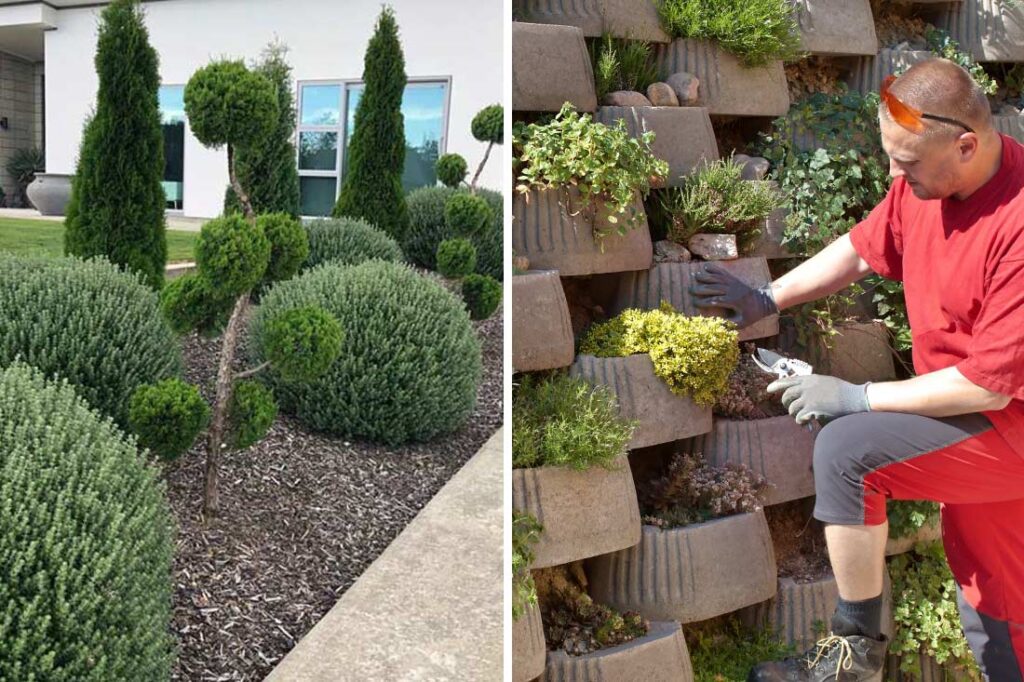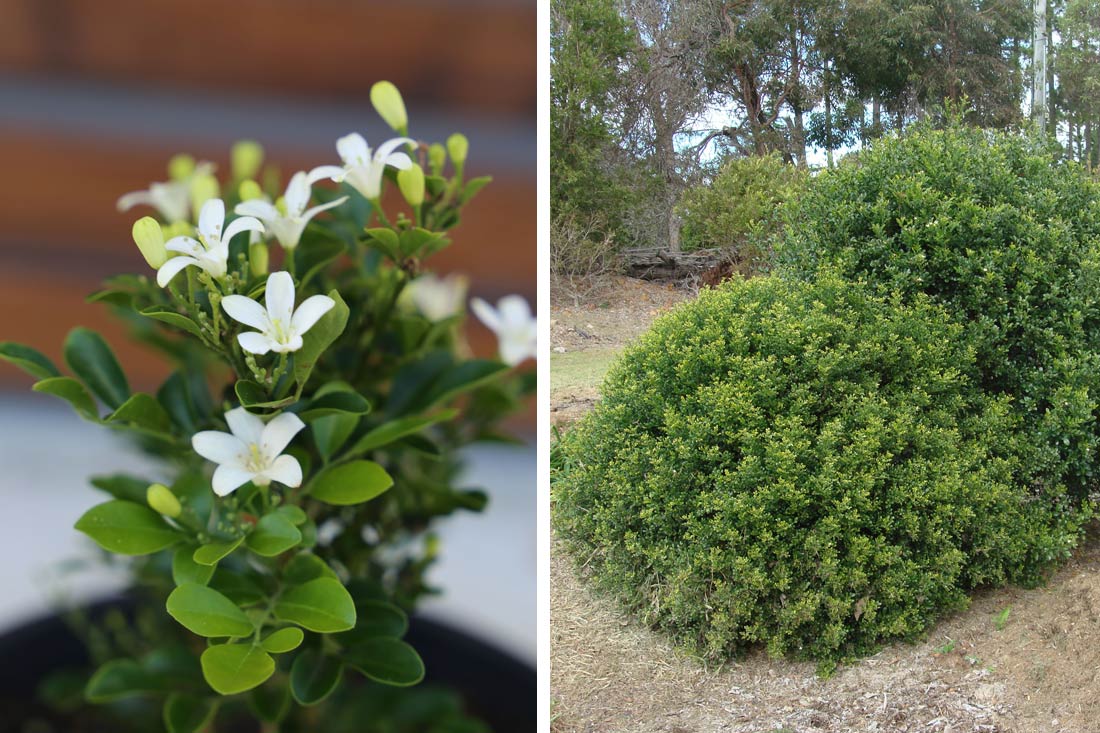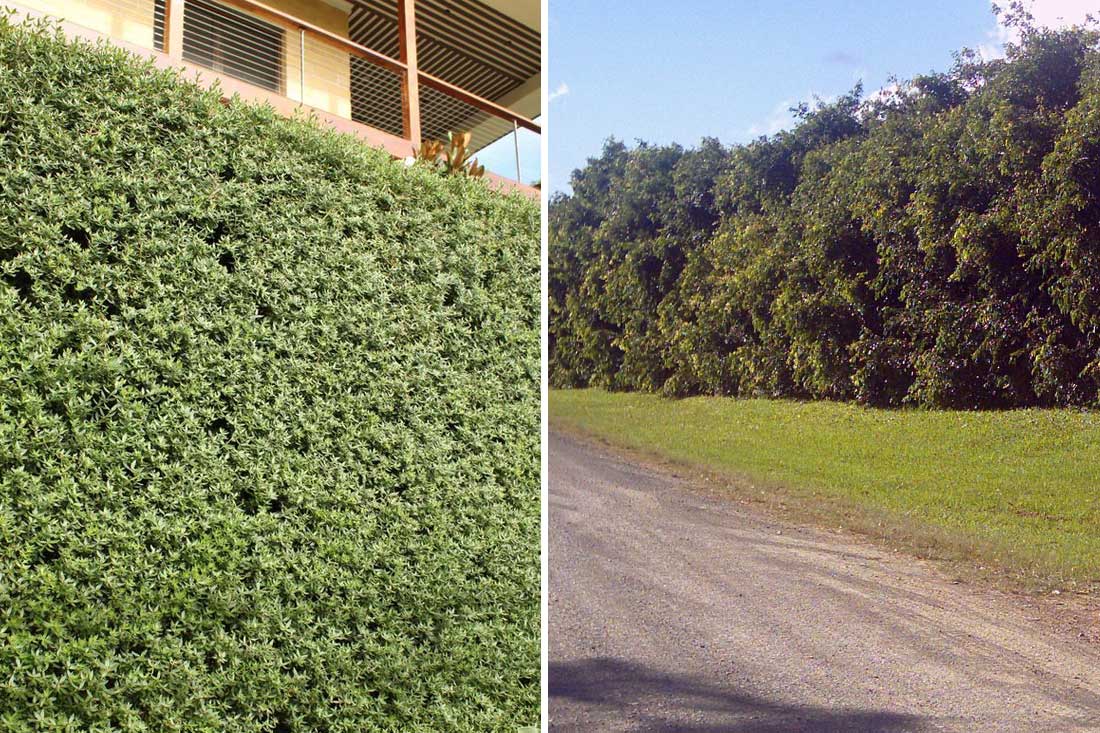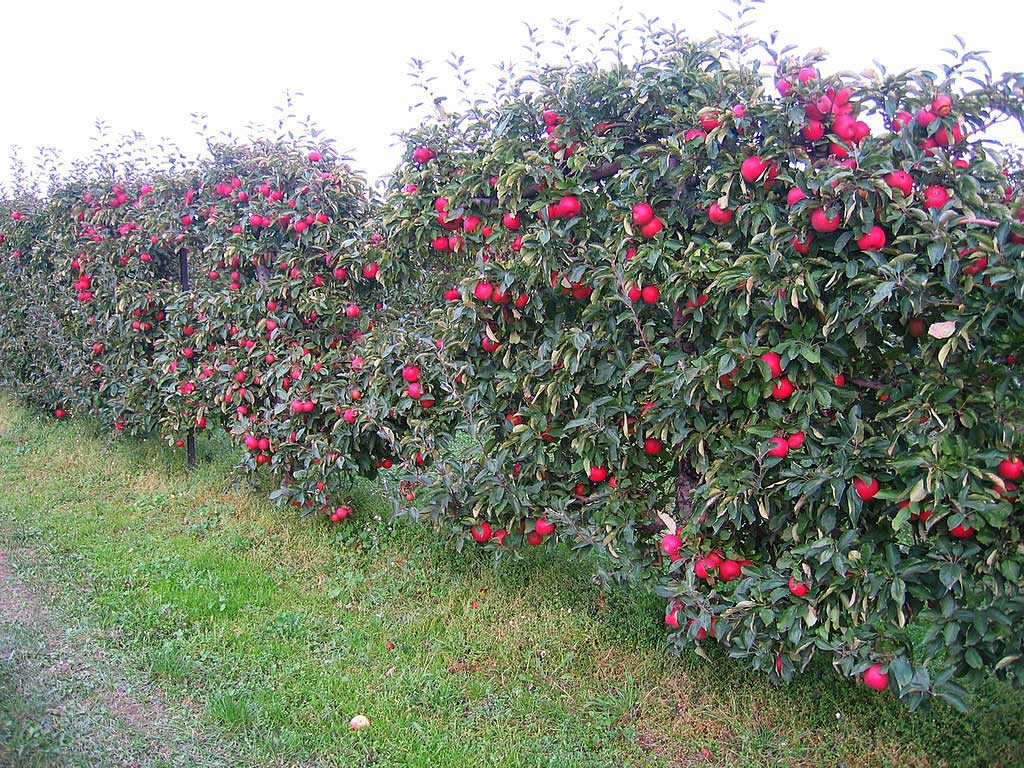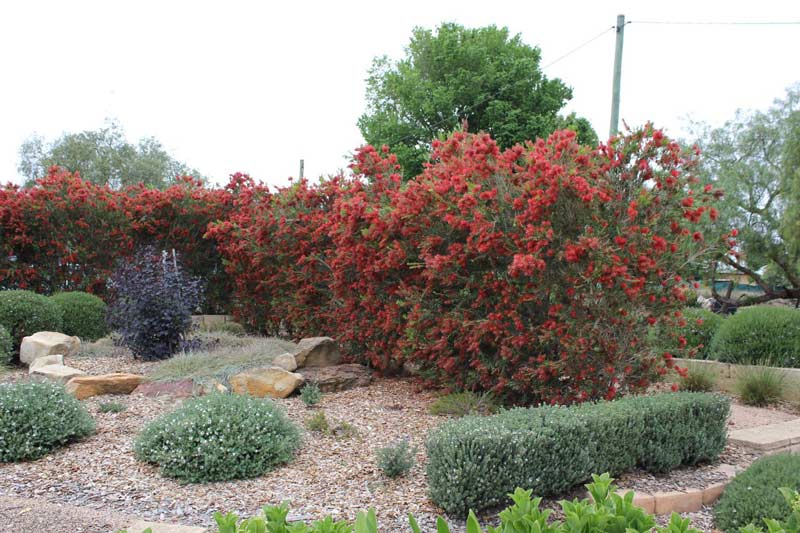Are you struggling to find the right plants that can thrive near heat-reflective surfaces like pavers, rocks, and concrete? These materials, common in many Australian landscapes, can create challenging conditions for plant growth due to their tendency to reflect and retain heat. As a result, nearby plants can struggle to gain enough moisture and prevent their leaves from scorching, slowing them down compared with nearby plants that aren’t experiencing the same stress.
In this article, we’ll provide practical, expert advice to help you select the best hedges and screens for these conditions, focusing on both native Australian and hardy exotic plants.
The plants in this retaining wall will experience a lot of reflected heat from the concrete and stones, especially if they face North or West because of the increased sunlight.
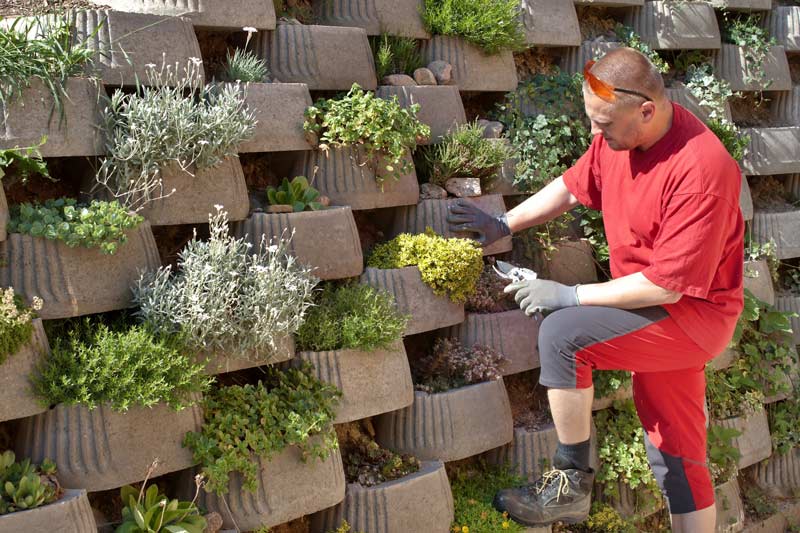
https://www.shutterstock.com/image-photo/man-gardener-relies-flowers-retaining-concrete-142234738
Understanding the Impact of Heat-Reflective Surfaces
What Are Heat-Reflective Surfaces?
Heat-reflective surfaces are materials that reflect a significant amount of sunlight, thereby increasing the temperature of their surroundings. Common examples include:
- Pavers
- Rocks
- Concrete
- Pathways
- Glass
- Metal
How Do They Affect Plant Health?
These surfaces can create several issues for plants growing nearby:
- Increased Temperature and Water Stress: The reflected heat elevates the local temperature, leading to faster evaporation of soil moisture and increased water demand from plants.
- Leaf Scorching: Intense reflected light can cause burns on plant leaves, reducing their ability to photosynthesise effectively.
- Soil Degradation: Repeated heating and cooling cycles can degrade soil structure and nutrient availability, further challenging plant growth. Especially for uncovered soil lacking mulch or ground-covering plants.
The Need for Resilient Plants
Plants that thrive near heat-reflective surfaces typically exhibit certain characteristics:
- Heat Tolerance: Ability to endure high temperatures without significant stress.
- Drought Resistance: Efficient water usage and deep root systems to access water from deeper soil layers.
- Structural Resilience: Strong, robust growth habits that withstand environmental stressors. Often, though not always, plants with blue-grey tones in their foliage seem to have adapted for such hot, sunny scenarios.
Criteria for Choosing Hedges and Screens
When selecting hedges and screens for areas with heat-reflective surfaces, consider the following criteria:
Heat Tolerance
Choose plants that can endure high temperatures and reflected heat without suffering damage.
Drought Resistance
Opt for species that use water efficiently and have adaptations for minimal water loss, such as deep root systems or specialised leaves. Plants that are suited for the heat in QLD and are listed as being drought-tolerant are good options.
Top Hedges and Screens for Heat-Reflective Surfaces
Native Australian Plants
Choosing native Australian plants does not ensure they’re suited to your local climate or for nearby heat-reflective surfaces. However, they hold a special place in our national psyche and to specify native plants is to celebrate our heritage.
Grey Box™ Westringia fruticosa ‘WES04’ PBR
Grey Box™ Westringia is a compact, drought-tolerant native plant that serves as an excellent alternative to the English box. It offers striking colour contrast with its grey foliage and produces white flowers from September to May. This versatile plant can be used for topiary, low hedges, borders, containers, and mass plantings. It can be left unpruned in its natural ball shape or pruned to maintain a tidier appearance. Not only is it drought tolerant, but it’s also tolerant of wet feet as well.
Size:
30 – 45 cm high x 30 – 45 cm wide
Soil Preferences:
Suits most soil types. Prefers a well-mulched garden with chunky mulch recommended.
Where it Works:
QLD, NSW, ACT, VIC, TAS, SA & WA.
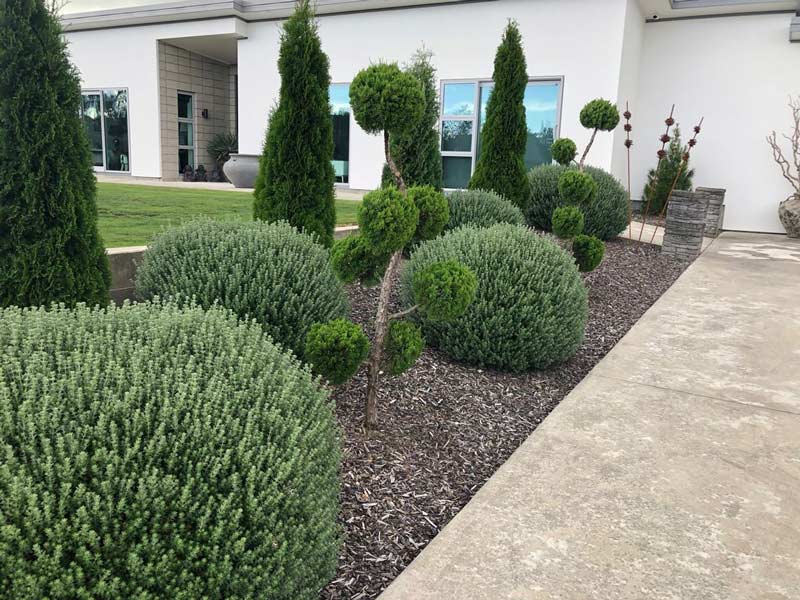
Planting next to concrete paths and driveways isn’t a problem for Grey Box Westringia. https://www.ozbreed.com.au/plant-ranges/native-shrubs-groundcovers/grey-box-westringia-is-a-drought-tolerant-native-box-hedge-plant-native-shrubs-ground-covers/
Coastal Pink™ Correa alba ‘COR10’ PBR
Coastal Pink™ Correa is a new pink-flowered form of the popular coastal Correa alba. It has a strong growth habit that makes it ideal for landscaping, particularly in coastal situations. The plant produces flowers with a more noticeable pink tinge compared to other Correa alba varieties. Be aware that this plant does not like excess moisture, and will perform better in cooler climates when situated near reflective heat objects.
Size:
Up to 2 metres high x 2 metres wide (can be maintained smaller with pruning).
Soil Preferences:
Prefers reasonably drained soil but is adaptable to most soil types. Plant in a well-mulched garden, with chunky mulch recommended.
Where it Works:
VIC, ACT, SA, WA, TAS, Southern NSW, and Sydney (in well-draining soils).

Coastal Pink Correa is great in heat-reflective situations, including sandy conditions. It’s also tolerant of frosts. https://www.ozbreed.com.au/plant-ranges/native-shrubs-groundcovers/coastal-pink-correa-copes-well-with-coastal-winds/
Macarthur™ Callistemon viminalis ‘LC01’ PBR
Macarthur™ Callistemon combines traits from two popular varieties, Little John and Captain Cook. This plant features a compact growth habit and displays flowers more prominently. It boasts fresh green-toned foliage and maintains a bushy, tidy appearance. It’s tolerant of both drought and flooding, making it perfect near retaining walls and depressed areas. The plant responds exceptionally well to pruning after flowering, making it an excellent choice for hedges.
Size:
1.8 metres high x 1.5 metres wide
Soil Preferences:
Tolerates most soil conditions. Requires planting in a well-mulched garden, with chunky mulch recommended.
Where it Works:
QLD, NSW, ACT, VIC, TAS, SA, & WA.
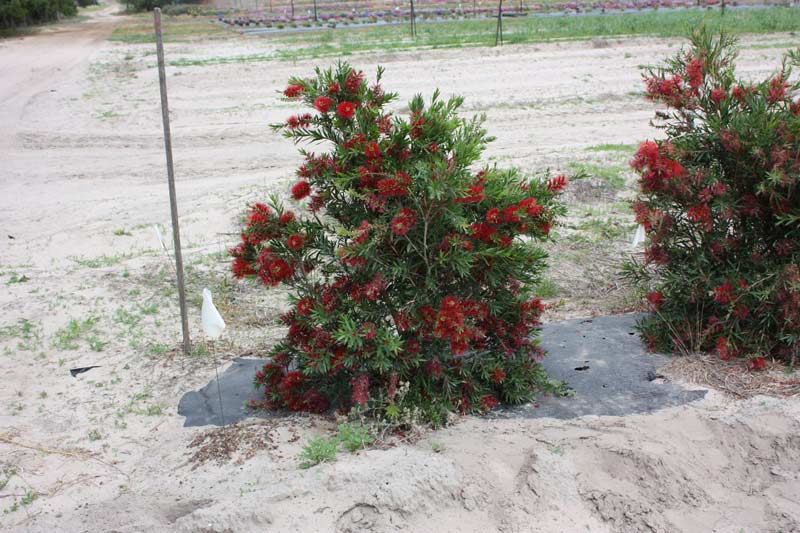
White sand is very reflective of heat, but it’s no match for Macarthur Callistemon. https://www.ozbreed.com.au/plant-ranges/native-shrubs-groundcovers/macarthur-callistemon-is-a-better-flowering-native-shrub-with-fresh-green-toned-foliage-native-shrubs-ground-covers/
Hardy Exotic Plants
Hardy exotic plants can also be excellent choices for heat-reflective areas. These species are selected for their resilience and ability to adapt to various environmental stresses, making them suitable for Australian landscapes. They’ll often provide similar benefits for our local biodiversity as native plants.
Sweet Privacy™ Murraya paniculata ‘MP01’ PBR
Sweet Privacy™ Murraya is a low-maintenance hedge or screen plant requiring less pruning than the common form, typically only 2-3 times a year. It’s notable for its fragrant, beautiful white flowers that appear in spring, late summer, and early autumn, making it a visually appealing and aromatic addition to any garden. It’s tolerant of drought and heat, making it a good option near heat-reflective surfaces.
Size:
1.8 – 2.5 metres high x 1.5 metres wide
Soil Preferences:
Works well with most soil types. It should be planted in a well-mulched garden, with chunky mulch recommended. Annual fertilisation with slow-release fertiliser is beneficial.
Where it Works:
QLD, NSW, NT, VIC, SA, & WA.
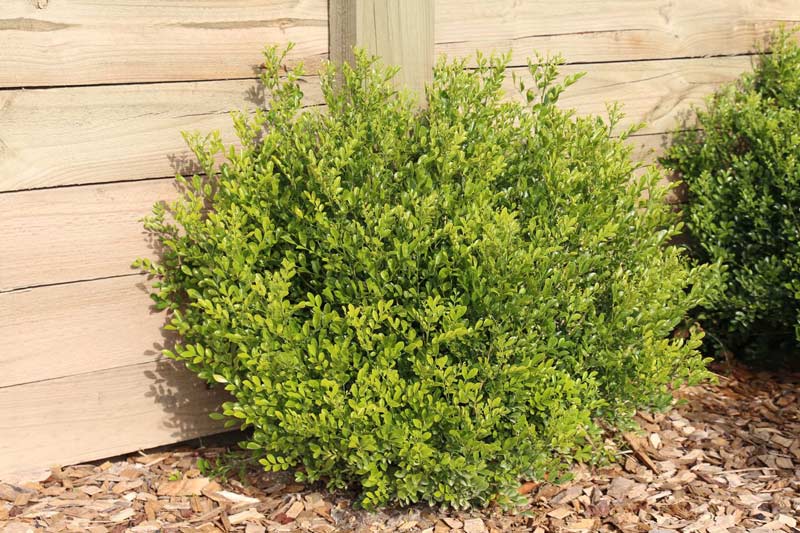
Timber doesn’t reflect heat as much as other materials, but this Sweet Privacy Murraya would tolerate it if it did. https://www.ozbreed.com.au/plant-ranges/hardy-exotic-range/sweet-privacy/
Cosmic White™ Rhaphiolepis indica ‘RAPH01’ PBR
Cosmic White™ Rhaphiolepis is a tough and resilient plant known for its impressive, large clusters of white flowers. This variety is drought tolerant and more resistant to diseases like Entomosporium fungal leaf spot than other Rhaphiolepis varieties, making it a reliable choice for hedges and screens in challenging conditions such as nearby objects reflecting heat.
Size:
1.5 – 2 metres high x 1.5 metres wide
Soil Preferences:
It can grow in most soil types but thrives in well-drained soils. Plant in a well-mulched garden, with chunky mulch recommended to retain moisture and regulate soil temperature.
Where it Works:
QLD, NSW, ACT, VIC, TAS, SA, & WA.
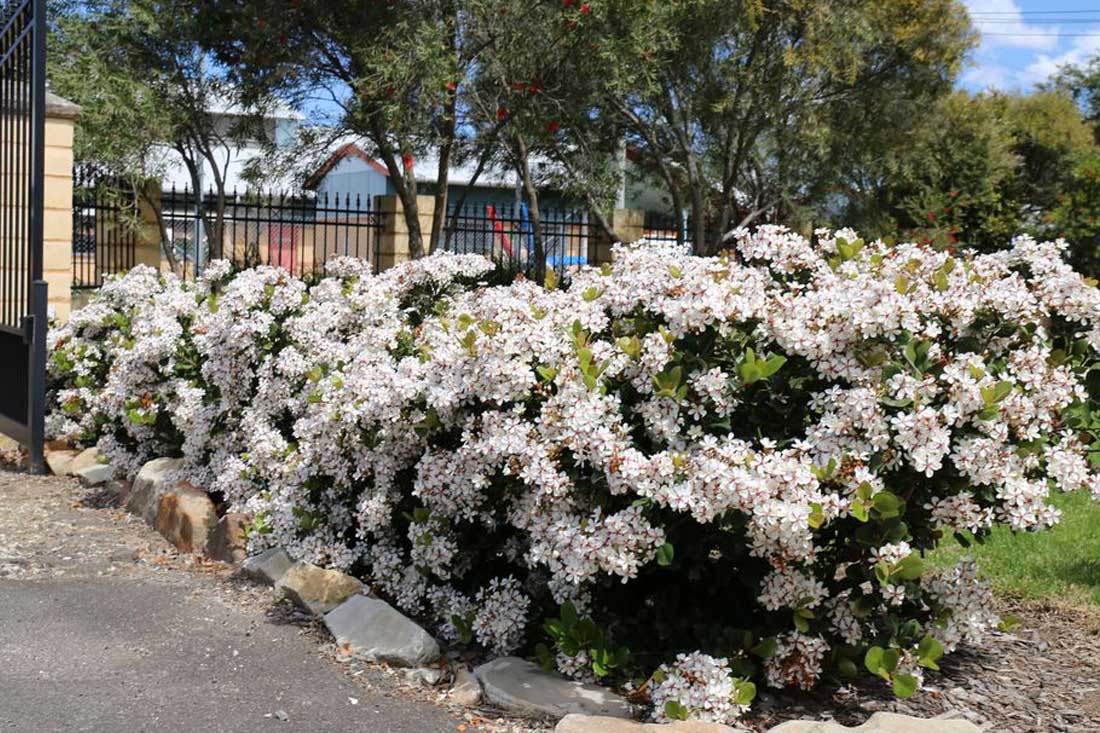
Cosmic White Rhaphiolepis is not just tolerating this heat-reflective position. It’s absolutely loving it! https://www.ozbreed.com.au/plant-ranges/hardy-exotic-range/cosmic-white-rhaphiolepis/
Blush™ Nandina domestica ‘AKA’ PBR
Blush™ Nandina is a compact, hardy plant with striking, red foliage that deepens in colour during autumn and winter. This plant adds year-round interest with its vibrant tones and minimal maintenance requirements. It is an excellent choice for hedges, borders, or mass plantings near reflective heat sources due to its drought and heat tolerance.
Size:
60 – 70 cm high x 60 – 70 cm wide
Soil Preferences:
Blush™ Nandina is adaptable to a variety of soil conditions but prefers well-drained soils. For optimal growth, plant in a well-mulched garden using chunky mulch to help retain moisture and improve soil health.
Where it Works:
QLD, NSW, ACT, VIC, SA, WA, and TAS.
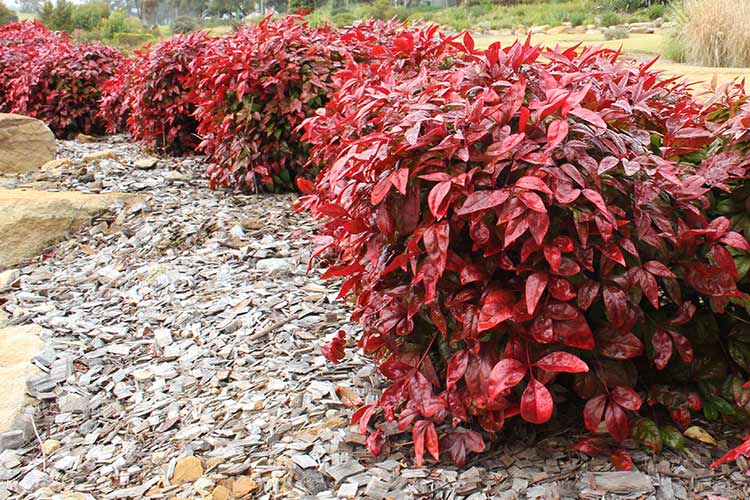
Blush Nandina hardly notices the heat reflecting from these rocks. https://www.ozbreed.com.au/plant-ranges/hardy-exotic-range/blush-nandina/
Practical Tips for Planting and Maintenance
Soil Preparation
Improving soil structure and drainage is crucial for the success of plants in heat-reflective areas. Consider incorporating organic fertilisers, hydro crystals, kaolin clay and/or other amendments to enhance soil quality and retain moisture.
Watering Strategies
Efficient irrigation methods, such as drip irrigation or soaker hoses, ensure that plants receive adequate moisture without water wastage. Extra water can be sent to areas with reflective heat, which will allow for the additional evaporation in the area.
Mulching
Applying mulch around plants helps retain soil moisture, regulate temperature, and improve soil structure. Chunky mulches like bark chips are particularly beneficial, as they allow for water and air to penetrate the soil more readily.
Regular Care and Pruning
Maintaining plant health and appearance through regular care and pruning encourages robust growth and prevents potential problems. It’s also an opportunity to monitor your plants and pick up on problems before they get out of hand.
Conclusion
Selecting the right hedges and screens for heat-reflective surfaces involves understanding the specific challenges these areas present and choosing plants that are heat-tolerant, drought-resistant, structurally resilient, and aesthetically pleasing.
By incorporating the right native Australian and hardy exotic plants, landscape architects can create beautiful, sustainable gardens even in the toughest conditions. Implement these tips in your projects to ensure better results and a flourishing landscape.

